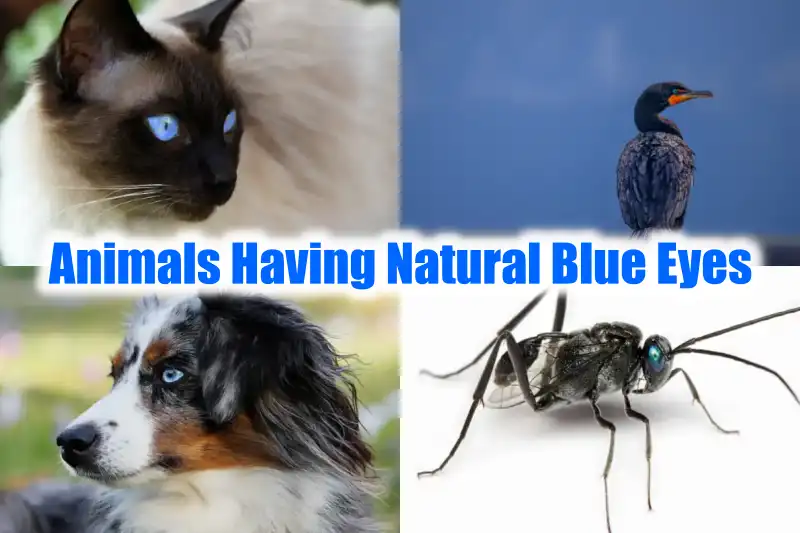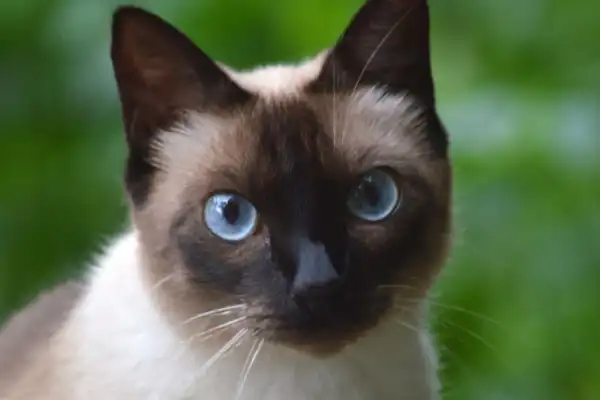The fact that blue is one of the rarest and most attractive eye colors is undeniable. But the percentage of animals with blue eyes is super low. The majority of animals in the wild have either light or dark eyes, while there are only some exceptions of blue eyes. To further enhance your knowledge, we put together an extensive list of 35 animals with blue eyes. This post will undoubtedly broaden your knowledge as you discover some stunning creatures bound to draw and keep your interest. So let’s get started. Happy scrolling!
Animals Having Natural Blue Eyes
I. What Birds Have Blue Eyes?
1. Satin Bowerbird
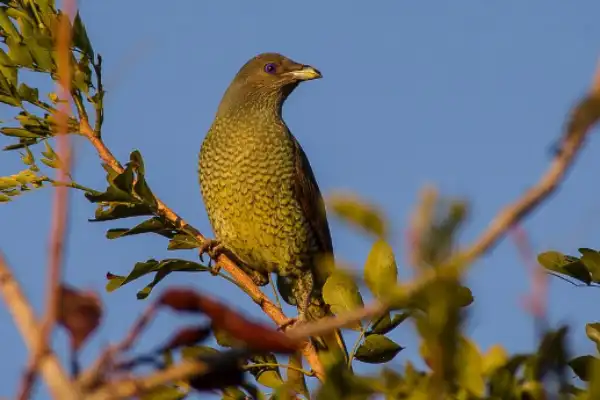
- Scientific name – Ptilonorhynchus violaceus
- Size – 27 to 33 cm
- Habitat – wetter forests and woodlands, and nearby open areas
- Diet – mostly on fruits throughout the year, and sometimes a few insects
The satin bowerbird is a species endemic to eastern Australia. This bird is obsessed with anything blue, and the credit goes to its own color.
This bird is popular among birdwatchers because of its curious antics and vibrant blue-violet eyes. Furthermore, it is very easy to spot as it searches the open woodland for food.
2. Blue-eyed Ground Dove
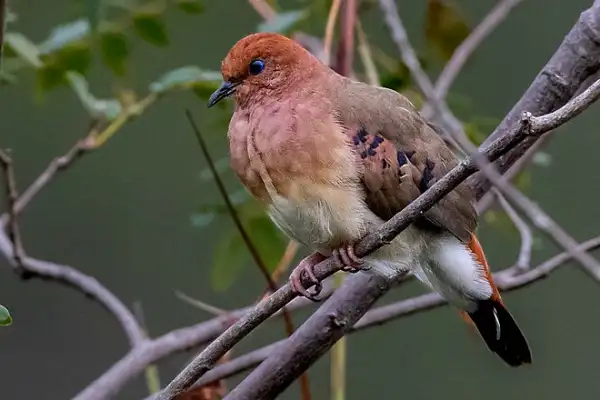
- Scientific name – Columbina cyanopis
- Size – 15.5 cm
- Habitat – open savannah and grasslands in the Brazilian cerrado
- Diet – seeds and small insects present in soil
This little, predominantly cinnamon-colored dove is known for its bright blue eyes, unlike most other doves whose eyes are dark brown or black.
This dove has an exceptionally charming appearance due to its gorgeous blue eyes and matching dots on its wings.
3. Western Jackdaw
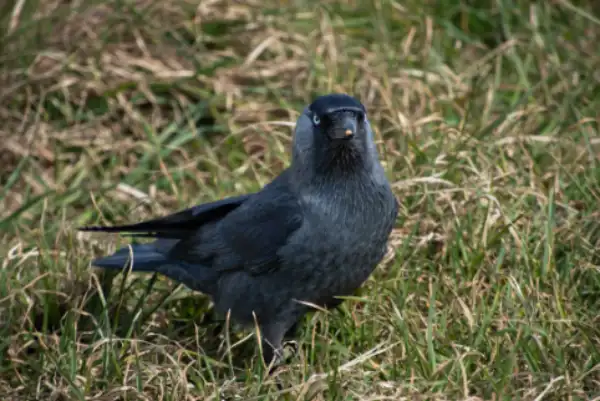
- Scientific name – Corvus monedula
- Size – 34–39 cm
- Habitat – wooded steppes, pastures, cultivated land, coastal cliffs, and towns
- Diet – They feed on beetles, spiders, snails, small rodents, bats, the eggs and chicks of birds, and carrion such as roadkill
One of the key characteristics that distinguishes the jackdaw, a common garden visitor, is its blue eyes (when it is a juvenile bird). It can also occasionally have a light grey nape and delicate white iris.
However, over time, this eye color changes. These turn dull brown at first, then gradually turn dull white, and then, when they are a year old or older, they turn silvery-white.
4. Blue-Eyed Shag
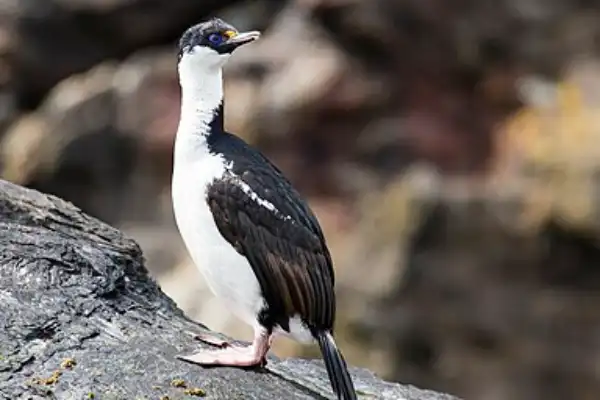
- Scientific name – Phalacrocorax atriceps
- Size – 69 to 74 cm
- Habitat – found around the colder parts of the Southern Hemisphere, especially near southern South America, Antarctica, and New Zealand
- Diet – Fish, crustaceans, octopuses, worms, snails, slugs
As the name implies, the blue-eyed shag lacks a blue iris but does have a blue or purplish ring around the eye. Since they all have similar characteristics, a number of species in the genus go by the same name.
Aside from the ring around the eyes, they are similar in that they have pink feet and, in some cases, white underparts.
5. Philippine Eagle
- Scientific name – Pithecophaga jefferyi
- Size – about 3 feet
- Habitat – endemic to the Philippines and lives around four major islands: eastern Luzon, Samar, Leyte, and Mindanao
- Diet – feed mainly on medium-sized mammals, such as flying lemurs, palm civets, flying squirrels, and monkeys
One of the three largest eagles in the world, the Philippine eagle is the only predator with blue-gray eyes instead of yellow, orange, or brown ones.
Long brown feathers with a white underside encircle the eagle’s face, giving it an old shag-like appearance. Yet, this bird is often praised for its magnificent appearance.
Giant Philippine eagles have high-arching, azure beaks and blue-grey eyes that are eight times more perceptive than human eyes.
6. Northern Gannet
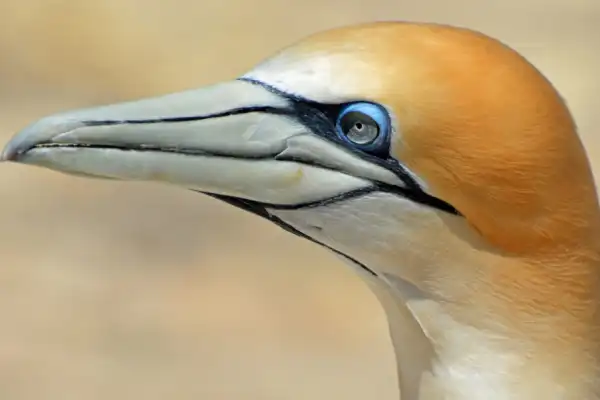
- Scientific name – Morus bassanus
- Size – 87–100 cm
- Habitat – spend most of their lives at sea, but sometimes living around many beaches on the Atlantic Coast
- Diet – almost exclusively fish, especially those schooling near the surface
The largest member of the gannet family is the northern gannet (Morus bassanus), a seabird. It is indigenous to the Atlantic Ocean shores, where it breeds in Northeastern and Western North America. Furthermore, it is the largest seabird in the northern Atlantic.
The adult northern gannet is characterized by a long neck, a streamlined body that is primarily white, and long, thin wings that are rimmed with feathers that are dark brown or black.
Its eyes, which have a black iris and a pale blue look, frequently resemble a blue ring.
7. Double-Crested Cormorant
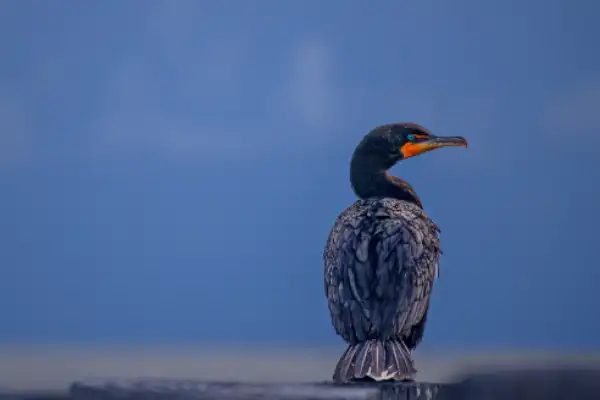
- Scientific name – Phalacrocorax auritus
- Size – between 70 to 90 cm
- Habitat – Coasts, bays, lakes, rivers
- Diet – feed primarily on fish, but also eat insects, crustaceans and amphibians
A cormorant’s teal-blue eyes, brilliant yellow throat pouch, and the tufts of feathers immediately above the eyes—for which it gets its name—make it stand out from other birds in every season around the year.
This unique bird has a wingspan of around four feet and measures little more than two feet in length. It features webbed black feet, a long tail, and dark brown to black feathers with a long hooked bill and an orange throat pouch.
8. Brown Pelicans
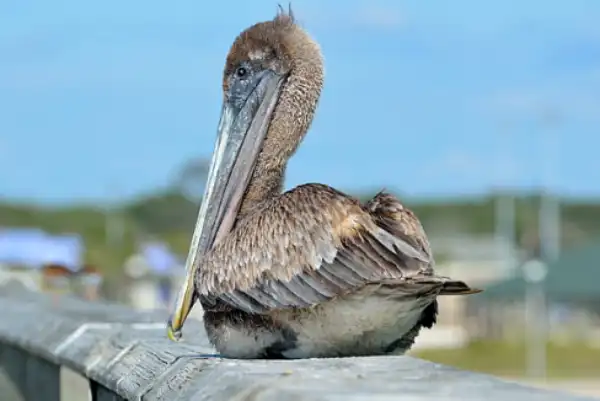
- Scientific name – Pelecanus occidentalis
- Size – 1 to 1.52 m
- Habitat – inhabits around coastal beaches and lagoons
- Diet – feed on mid-sized fish and some invertebrates
It’s a gray-brown bird with a white neck and yellow head. While the most attractive feature is its pastel blue eyes with slightly darker iris.
In addition, the sides and rear of the neck develop a deep, rich reddish-brown color during breeding. On the other hand, immatures have a pale, whitish abdomen and breast and are gray-brown above, including the head and neck.
9. Neo-tropic Cormorant
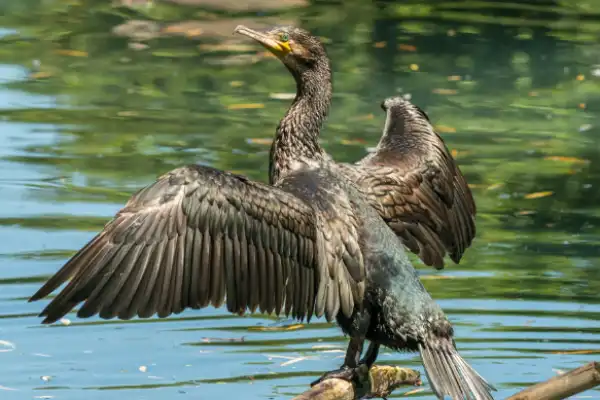
- Scientific name – Phalacrocorax brasilianus
- Size – 61 to 74 cm
- Habitat – found around fish farms, ponds, lakes, reservoirs, rivers, inlets, and bays
- Diet – they mostly eat fish and shrimp, as well as frogs and insect larvae such as dragonfly nymphs
With their aquamarine eyes and dark coloring, these cormorants draw a lot of attention from speculators.
Its distinctive features include small size, emerald blue eyes, a grayish bill, and a pale yellow gular (throat) pouch with a prominent white ‘V’ of feathers outlining the pouch.
10. Brandt’s Cormorant

- Scientific name – Phalacrocorax penicillatus
- Size – around 79 cm tall
- Habitat – coastal birds
- Diet – seafood diet, primarily fish and squid
Adding another cormorant bird to the list of animals with blue eyes! It’s a big water bird with a narrow neck and oval body.
When they reach breeding age, adults have a vibrant blue skin patch on their gular pouch and are primarily black with a purplish shimmer. Yet, the most striking characteristic is the sheen of its blue eyes.
II. Dogs Among Animals With Natural Blue Eyes
11. Siberian Husky

- Scientific name – Canis lupus familiaris
- Size – 21-23.5 inches (male) & 20-22 inches (female)
- Habitat – extremely cold and harsh environment of the Siberian Arctic
- Diet – high-protein diet, meat
Among animals with blue eyes, the Siberian Husky is one of the most majestic. One of the most remarkable things about huskies is their eye color. Furthermore, mix breeds are frequently referred to as “Husky crosses” based only on the presence of one or two blue eyes because they are so well-known for possessing light-blue, green, or even mismatched eyes.
12. Australian Shepherd
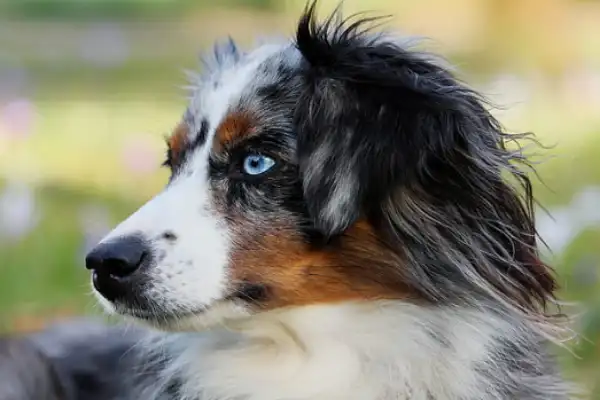
- Scientific name – Canis lupus
- Size – Male: 51–58 cm, Female: 46–54 cm
- Habitat – originated near the Pyrenees Mountains
- Diet – high-quality animal-based protein sources, such as beef, chicken, turkey, lamb, duck, eggs, and fish
The Australian Shepherd, though we affectionately refer to them as Aussie, is one of the few dog breeds that often exhibit heterochromia, having two distinct colored eyes.
Aussies can have eyes that are any shade of brown, blue, hazel, amber, or green. In fact, in some cases, they exhibit multiple colors in the same eye. It is, therefore, undoubtedly a fascinating creature.
13. Weimaraner Dog

- Scientific name – Canis lupus
- Size – Female: 59–63 cm, Male: 62–67 cm
- Habitat – dense forests of Germany’s Weimar region
- Diet – high-quality animal-based protein sources, such as beef, chicken, turkey, lamb, duck, eggs, and fish
Weimaraners, who were once employed as hunting dogs in Germany, are known for their characteristic amber or blue-gray eyes and silvery-gray coats. Considering how much exercise and running they adore, these puppies are rather high-maintenance.
The eyes of Weimaraners puppies have varying hues of blue, sometimes with a grayish tone. Sadly, they do not maintain their blue eyes for the rest of their lives; instead, they change color.
14. Alaskan Klee Kai

- Scientific name – Canis lupus
- Size – 33-44.5 cm tall
- Habitat – Wasilla, Alaska
- Diet – high-quality animal-based protein sources, such as beef, chicken, turkey, lamb, duck, eggs, and fish
The eyes of the Alaskan Klee Kai breed can be either icy blue, brown, hazel or sometimes green. In many households, these tiny dogs make wonderful little companions and excellent watchdogs.
Even though brown eyes are the most common among them, several Alaskan Klee Kai have stunning ice-blue eyes. And that’s what draws most people to these animals with blue eyes.
III. Other Animals With Blue Eyes
15. Blue-Eyed Black Lemur Or Sclater’s Lemur
- Scientific name – Eulemur flavifrons
- Size – 12 to 18 in.
- Habitat – primary and secondary subtropical humid forests
- Diet – they most often eat fruits and leaves
One species of true lemur is the blue-eyed black lemur (Eulemur flavifrons), commonly called the Sclater’s lemur. This means that they are medium-sized primates living only around Madagascar and that they are members of the genus Eulemur.
As its name suggests, it primarily has a black body with perfectly round blue-gray to electric blue eyes.
16. Blue-Eyed Cuscus
- Scientific name – Spilocuscus wilsoni
- Size – Head-body 33.5-48 cm
- Habitat – several of the islands in the Cenderawasih Bay in West Papua of Indonesia
- Diet – They eat the leaves of ficus, alstonia, and slonea plants, nectar, and the fruits of ficus
There is this species that is quite interesting, although being smaller in size than the other Spilocuscus species. And a crucial factor in its attractiveness is its distinctive pale blue eyes.
Another noticeable feature of the blue-eyed spotted cuscus is the pale marbled coat of the blue-eyed spotted cuscus, which has shades of brown, grey, and white with a creamy white underside.
17. White Tiger
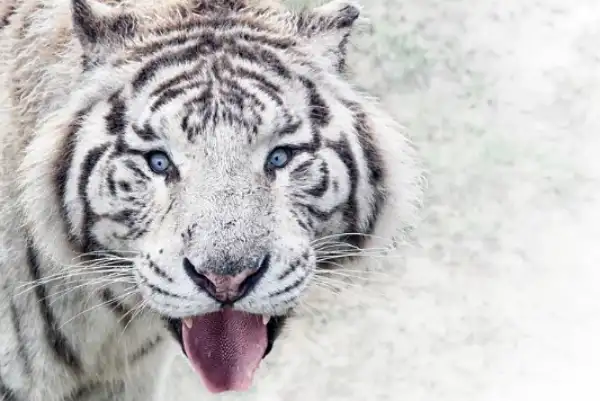
- Scientific name – Panthera tigris
- Size – up to 3 m
- Habitat – the forests and wetlands of India, Bangladesh, Bhutan, and Nepal
- Diet – large prey, including boar, goat, cattle, and deer
Did you know that white tigers have blue eyes and fur that can range in hue from creamy to white? They are not albinos.
There are numerous myths surrounding the White Tiger, which is said to be a fantasy or mystical animal. These Bengal Tigers, described as “blonde, blue-eyed,” are factually white-furred, blue-eyed tigers.
Tragically, these gorgeous animals with blue eyes are prone to arthritis, associated dysplasias, shorter lifespans, and thin skin, particularly on the elbows, knees, and hips.
18. Bold Jumping Spider

- Scientific name – Phidippus audax
- Size – 13–20 mm
- Habitat – grasslands, chaparrals, open woodlands, and agricultural fields
- Diet – They prey on a variety of insects and non-insect terrestrial arthropods such as caterpillars, dragonflies, grasshoppers, and other spiders
It may surprise you to learn that Bold Jumping Spiders can literally go blind from hunger.
Yes, you read correctly: bold jumping spiders that are undernourished start to lose their light-sensitive photoreceptors.
Yet, this species is born with magnificent metallic dark eyes that have a blue-green hue, which makes it a wonderful sight for someone hoping to witness animals with blue eyes.
19. The Pacific Blue-Eye
- Scientific name – Pseudomugil signifer
- Size – males: 8.8 cm and females: 6.3 cm
- Habitat – clear, fast flowing streams and also in mangrove regions of estuaries
- Diet – They primarily feed on suspended or floating phytoplankton, zooplankton and invertebrates
Eastern Australia is home to a particular kind of fish called the Pacific blue-eye. This fish, as its native name implies, has exquisite long, colorful fins and stunningly fluorescent blue eyes.
The iris of this fish is blue, and its semi-transparent body might be pale olive, yellow, or bluish in tone. Additionally, the operculum and belly are silvery, and the side of the body often displays a string of pearly dots.
20. White Vienna Rabbit
- Size – more than 9 inch
- Habitat – domestic rabbit originating in Austria
- Diet – fiber-rich diet, consisting mainly of vegetables and alfalfa hay
White Vienna Rabbit is most famous for its beautiful blue eyes, snowy fur, and docile, friendly nature. Furthermore, this lovely creature grabs all your attention in one go with its dense coat of glossy, smooth hair.
These bunnies, with barrel-shaped bodies, tend to be medium to large breeds with well-developed muscles. They also have furry ears, which is another characteristic that sets them apart from other breeds.
21. Blue-eyed Ensign Wasp
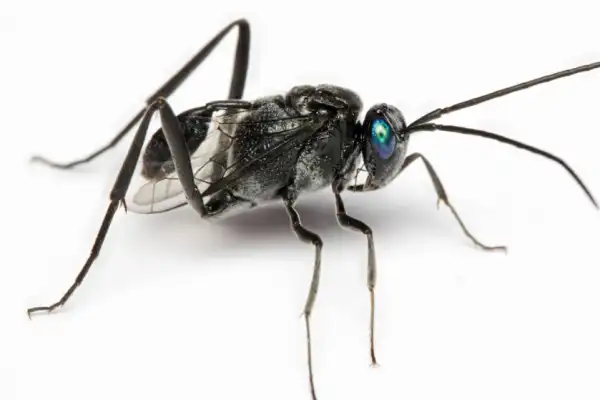
- Scientific name – Evania appendigaster
- Size – 1 to 1.5 cm
- Habitat – throughout the tropics and subtropics and in many temperate regions
- Diet – It is a parasitoid known for specializing on cockroach eggs
On our list of animals with blue eyes, this unique wasp with brilliant Pacific blue eyes must have a place.
This ensign wasp is among the largest, with its forewings reaching a length of approximately 7 mm. What makes it unique is its black body with contrasting electric blue eyes.
Evania appendigaster likely has an origin in Asia. While today, it lives around many temperate zones as well as the tropics and subtropics. The blue-eyed ensign wasp is a parasitoid that feeds primarily on cockroach eggs, just like the other members of its family.
22. Blue Dasher
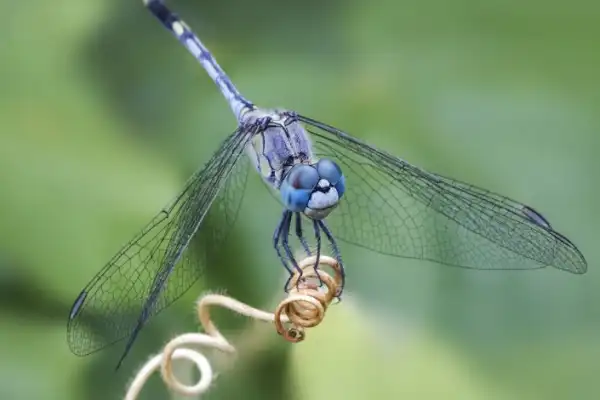
- Scientific name – Pachydiplax longipennis
- Size – 25–43 mm
- Habitat – near still, calm bodies of water, such as ponds, marshes, slow-moving waterways, and ditches
- Diet – insects including mosquito and mayfly larvae
Several dragonflies chase gnats, midges, mosquitoes, and other small flying insects. One such species is the blue dasher. Its name deeply signifies its appearance. A mature male Pachydiplax longipennis, a blue dasher, has a white face, turquoise blue eyes, and a blue body with a dark abdomen tip.
23. Blue Eyed Angle-head Lizard
- Scientific name – Gonocephalus liogaster
- Size – (snout to vent) : males up to 14.5 cm, females up to 12 cm
- Habitat – Tropical forests of Indonesia and Malaysia
- Diet – leafy greens and insects
This lizard easily wins the prize for having the most dramatic eyes, if you’ve ever had to choose one. But, in reality, there isn’t a competition like that.
Nonetheless, adult males of this species have a very attractive personality due to their vivid blue iris encircled by a bright orange ring.
Living in the tropical isles of Malaysia and Indonesia, the blue-eyed angle-head lizard is a species of forest dragon that has received only a little scientific attention.
24. Blue-Eyed Leucistic Ball Python

- Scientific name – Python regius
- Size – 3 – 5 Feet
- Habitat – African grasslands
- Diet – rodents, such as mice or rats
The eyes of these stunning white snakes have a vivid blue color. Hence, they appear on our list of animals with blue eyes. When the Mojave ball python crosses with the smaller ball python, it produces these specific variants.
Because they are totally white and show no signs of their typical coloring, these pythons are extremely rare. They are not albinos, though. Albino pythons are highly light-sensitive and have reddish-pink eyes.
25. Mississippi Green Watersnake
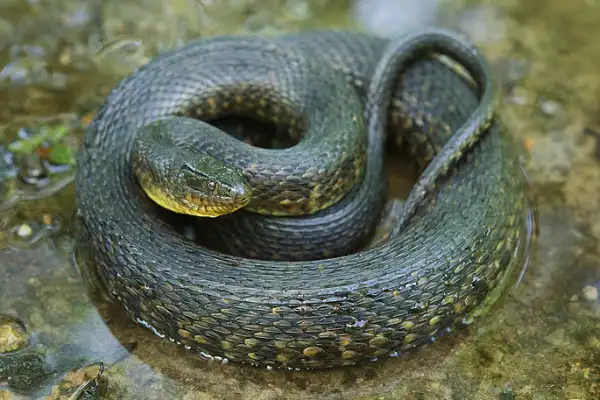
- Scientific name – Nerodia cyclopion
- Size – 30-45 inches
- Habitat – quiet waters of swamps, wetlands, river sloughs, and lake edges
- Diet – fishes, frogs, tadpoles, crayfish, and salamanders
The Mississippi green watersnake is a heavy-bodied, semiaquatic, medium-sized, dark olive to brown snake with apparent light and dark speckles. Meanwhile, these animals’ brownish-blue eyes are their most intriguing feature.
IV. Cats Cannot Miss The Spot Among Animals With Blue Eyes
26. Birman Cat

- Scientific name – Felis catus
- Size – 8 to 10 inches
- Habitat – common domestic cat
- Diet – high-protein, low-carb diet
It’s difficult to resist the blue-eyed Birman cat breed. They have a charming beauty that will make you want to do anything for them, especially their shiny blue eyes. This breed is extremely gentle, compassionate, and playful, making them the perfect family pet.
27. Siamese Cat
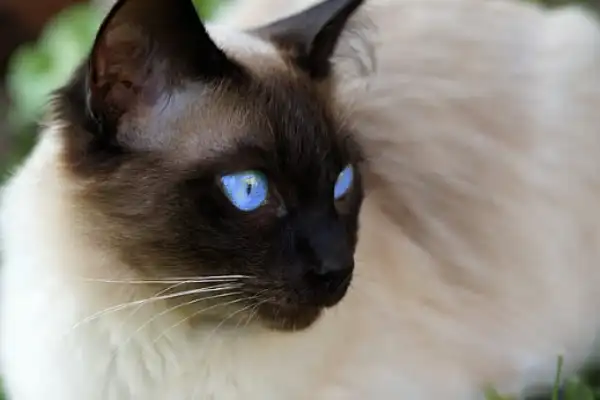
- Scientific name – Felis catus
- Size – 8 to 10 inches
- Habitat – common domestic cat
- Diet – grain-free, high-protein wet food
Let’s get some facts out of the way – All Siamese cats have blue eyes! As well as darker points with paler bodies.
The two characteristics—the blue eyes and the color-point pattern—come from the same mutation, a type of temperature-sensitive albinism in which melanin can only form on the skin’s colder regions (tail, feet, ears, nose). These features make this one a unique breed.
28. Balinese Cat

- Scientific name – Felis catus
- Size – 8 to 11 inches
- Habitat – common domestic cat
- Diet – high-quality protein diet
The Balinese is an elegant breed of domestic cat with gorgeous deep blue eyes and a silky, flowing coat. The exotic dancers of Bali are the inspiration behind the name of this particular breed for its long and graceful physique.
Their eye color ranges from pale blue to sapphire. Furthermore, age and diet can have a modest impact on color intensity.
29. The Ragdoll Cat

- Scientific name – Felis catus
- Size – 9 to 11 inches
- Habitat – strictly house cats
- Diet – a lot of meat and animal protein
The ragdoll cat’s eye color is determined by the same genes that determine its point color, much like the last two breeds.
Almost all Ragdolls have piercing blue eyes.
A tiny percentage might only have one blue eye. On the same side as their blue eye, these cats often have deaf ears.
30. Thai Cat
- Scientific name – Felis catus
- Size – 11 to 14 inches
- Habitat – common domestic cat
- Diet – balanced, rich and varied diet
Thai cats are a special breed because of their lively personalities and not only their gorgeous blue eyes. People prefer them as pets since they are more like a dog friend than individualist cat.
Surprisingly, this cat’s extreme devotion to the owners is evident in their appearance and mannerisms.
Thai cats come in four coat colors: seal, blue, chocolate, and lilac, in addition to red and cream.
31. Himalayan cat
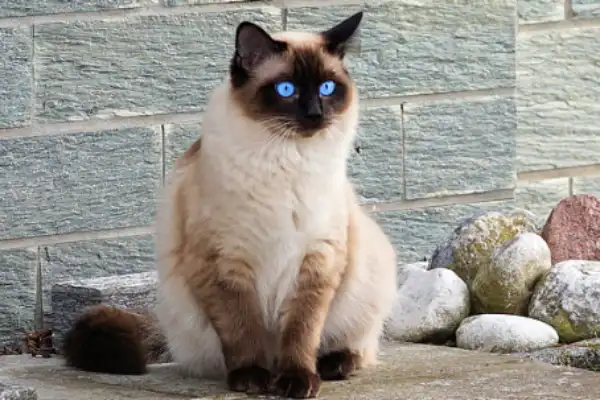
- Scientific name – Felis catus
- Size – up to 11 inches
- Habitat – common domestic cat
- Diet – rich fiber diet
The one and only eye color of the Himalayan cat is “deep vivid blue.” This characteristic makes it unique. Often, their beautiful blue eyes will contrast sharply with the darker fur surrounding their face. That means their faces, ears, feet, and tails are darker than their creamy bodies.
32. Ojos Azules cat

- Scientific name – Felis catus
- Size – 8 to 10 inches
- Habitat – feral cat colony in New Mexico
- Diet – high in meat-based protein
They possess vibrant blue eyes along with a striking, unique, and utterly gorgeous aura. Hence, they never miss to steal the hearts of pet enthusiasts. Yet, as this breed is so rare, not much is known about their personalities.
Even though their coat colors may differ, they must share their vivid, deep blue eyes. Moreover, they are never completely white—rather, they frequently feature white patches.
33. Colorpoint Shorthair
- Scientific name – Felis catus
- Size – up to 24 inches
- Habitat – common domestic cat
- Diet – protein-rich cat food
Color-point Shorthairs are beautiful animals with blue eyes. Apart from its gorgeous coat that lays near the skin, this cat is unusually long and has a long neck, tail, body, and tail.
The almond-shaped eyes of Color-point Shorthairs tend to be medium in size. Many cat owners claim that blue eyes are the most gorgeous hue, giving the appearance of crystals in their eyes.
34. White Persian cat

- Scientific name – Felis catus
- Size – 10 to 15 inches
- Habitat – common domestic cat
- Diet – food rich in whole meat, fish, and organs
The gray fur of the original Persian cat was glossy. But today, because of selective breeding, they come in different colors. In fact, there are actually 7 distinct coat color divisions.
They come in a variety of colors, from silver and gold to white, smokey, and solid. Their coat color complements the color of their eyes. Thus, white Persians typically have rich blue-colored eyes.
35. Snowshoe cat

- Scientific name – Felis catus
- Size – 8 to 13 inches
- Habitat – common domestic cat
- Diet – high-quality meat-based diet with an adequate amount of the amino acid taurine
One of these creatures’ signature characteristics is their blue eyes. Their eyes can have a variety of blue tones, ranging from a light sky blue to a deep, intense azure.
The eyes of snowshoe cats are always more rounded than those of their Siamese predecessors, hence a walnut-shaped appearance.
Conclusion
Many amazing creatures can be found thriving in their natural habitat out in the open. But above all, the animals with blue eyes are the ones that most easily fascinate us. Thus, we have listed 35 of these animals having natural blue eyes in this article. I sincerely hope you have enjoyed reading it and will return for many more updates. Until then, we would be delighted to hear your thoughts.
Also Read:

Anjali Prasad, a B. Pharm. graduate who works as a content writer for HowItSee, is based in Delhi. Except for her, not many people take the typical road from healthcare to writing. Her love of writing stemmed from her involvement in the college literature society and her early journaling at the age of 7. Hence, the love of learning and the spirit of exploration are what drew her to this career. You can find her on common social media like Instagram.
